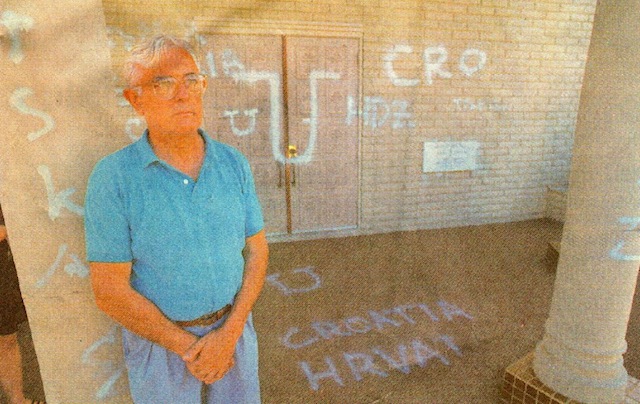
Spray-painted words called ‘hate crime’
Centuries of bad blood in Eastern Europe boiled over in Phoenix on Friday when members of St. Sava Serbian Orthodox Church found Croatian profanities sprayed on the walls of the onion-domed church.
“Here, I find the same guys who killed my father, my brother, my uncle, 45 of my relatives, are desecrating my church,” said Vlado Brodich, president of the church board of directors.
Brodich said he discovered the graffiti about 6 a.m. Friday when he arrived at the church, near 44th and McKinley streets.
“This is definitely a hate crime,” Brodich said.
Police apparently agree; they are investigating the incident as a hate crime, a police spokesman said. The FBI also has been asked to investigate.
Despite the bloody civil war that has ravaged the former Yugoslavia, Brodich said, there had been no hate crimes involving Valley residents of Serbian or Croatian descent.
But after viewing the vandalism, Brodich said, “We are facing the same aggression we faced during the civil war.”
Brodich had no estimate of the damage, which occurred between 6 p.m. Thursday and 6 a.m. Friday.
The vandals wrote their slogans in Croatian, with the exception of a common profanity scrawled above the church’s front door. They also urinated on the door.
Brodich translated the profanities, saying that one slogan referred to the “Black Legion,” a Croatian group aligned with the Nazis during World War II.
Another word, “Ustasa,” refers to Croatian rebels who fought against Serbs in the civil war.
Brodich said the vandals struck St. Sava on the first anniversary of a massacre in the Krajina, a region of southeastern Yugoslavia where the Croats bloodily expelled the Serbs.
Brodich said he was uncertain whether church leaders would remove the graffiti right away or leave it for members to see so that they would realize the level of anti-Serb sentiment among some Croats.
“This came as a total shock,” said Brodich, who emigrated to the United States after World War II. “We have lived peacefully here for many years.”
For example, he said, all sorts of Slavic people get along well with each other at a Slavic social club across the street from the church.
![]()
Note: I can attest to the fact that the Balkan feuds carried over to Croatians and Serbs who had been in the United States for several generations. A friend I played soccer with was Croatian. His wife was a neo-natal nurse. One day in Milwaukee, which has significant numbers of both Croats and Serbs, a Serb husband refused to allow the Croatian nurse to assist in his child’s birth!
![]()
By Jim Walsh
Staff Writer
Arizona Republic
August 10, 1996
| 432nd members back with families | Graffiti Mars Serbian Church | Bosnia after Dayton: Year Two |
